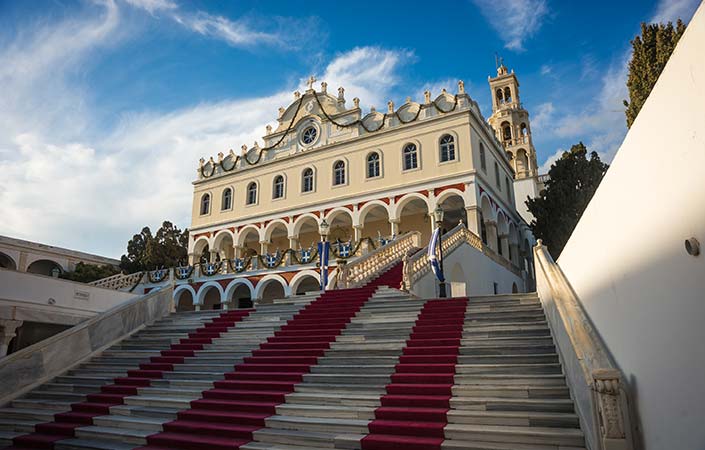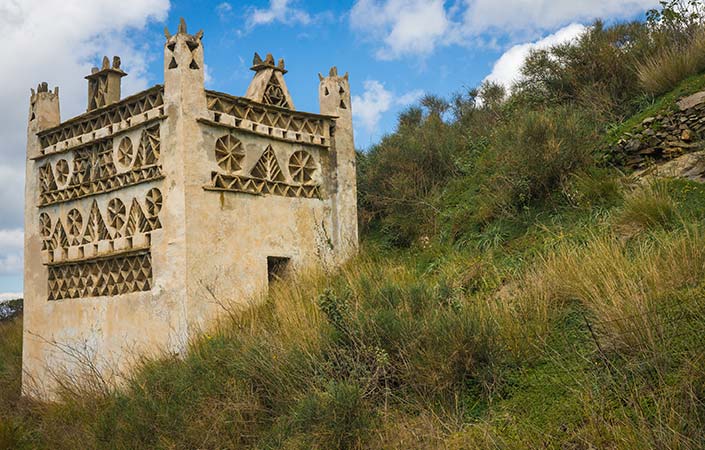Tinos
Tinos, the holy island of Virgin Mary, receives each August thousands pilgrims who visit it in order to pray or to offer their oblation. The religious ceremonies take turns with the trade fair at the alleys.
Tinos, the capital and the port, gathers the biggest part of the population. The church of Panagia, built by marble of Paros and Tinos, hulks over the city on the place that the holy icon was found. Next to the church stands the Museum of Tinians artists while close by is located the Archaeological museum, where are exhibited the findings from Poseidon and Amfitriti temples, as well as from the geometric period tombs at Exo Meria.
Another important monastery is the one of Our Lady of Angels that resembles a medieval village.
The 45 picturesque villages of Tinos maintain their traditional atmosphere, being unique samples of folklore art. Among them distinguish the big villages Steni and Pirgos with Giannoulis Halepas’ house and the marble sculpture workshops.
At Tarampados region, see the dovecotes dated back to 17th and 18th century built according to a special architectural style.
Aghios Fokas, Kionia, Porto, Panormos bay, Aghios Sostis and Pachia Ammos are ideal for swimming.
The lunar like landscape “Volax” with the peculiar round rocks is considered a unique phenomenon around the world.
Sights
- The church of Panagia of Tinos where the famous icon of Virgin Mary was found in January of 1823 after a Saint Pelagia’s vision. The miraculous icon is considered to be an artwork of Luke the Evangelist. The temple was founded in 1823 at the position of an older church of Saint John the Baptist. During ancient times, at the same spot was located a Dionysus sanctuary and a theatre.
- The church of Taxiarches with the amazing wood carved iconostasis dated back to 18th century.
- The monastery of Our Lady of Angels (Dormition of Mother of God) at Kechrovouni that was founded in 11th or 12th century, where Saint Pelagia was a nun.
- The monastery of Aghia Triada at Girla dated back to 18th century
- The church of Panagia Bourniotissa with the miraculous icon found in 1670.
- The monastery of Panagia Katopoliani dated back to 1786, the church of Aghia Eleousa, Kira Xeni and many others.
- Tinos has many Catholic churches as the cathedral of Panagia Rodarios at the village Xinaras. Other important catholic churches are Panagia Brisios, the monastery Heart of Jesus and the monastery of Ursulines dated back to 1862.
Museums
- The Archaeological Museum of Tinos hosts the findings from the temples of Poseidon and Amfitriti, but also from the Geometric period tombs at Exo Meria.
- The Cultural Foundation of Tinos Island
The Elli Mausoleum dedicated to the victims of the protected cruiser Elli’s sinking in 1940, that is located next to the entrance of the Church of Virgin Mary. - The Museum of Tinian Artists
- The Gallery with artworks of Greek and foreign painters
- Giannoulis Halepas’ house at Purgos where are exhibited artworks of the artist.
Others
- The sanctuary of Apollo and Amfitriti dated back to 3rd century BC
- The lunar like landscape “Volax” with the peculiar round rocks is considered a unique phenomenon around the world.
History
Tinos is known from the neolithic times and should be chronologically identified with the birthday of Petra.
The present mainland of Greece, millions of years ago was connected to Asia Minor and the Aegean Sea did not exist. The area called Aigis sunk and the residues, the islands that are saved up to today, are the remnants of mountaintops.
Based on an insistent tradition of the ancients, the island took its name from the name of the first resident that was called Tinos, head of a team of Iones that came from Asia Minor. Another tradition also ancient says that Tinos was named Ydrousa for her abundant waters and Ofiousa or Fidousa for her many snakes. The name Tinos should emanate from the Phoenician – Soumerian word Tannoth that means reptile.
Information on the island history in the prehistoric years is very little. As the excavations showed Tinos was inhabited at the Copper Ages and all through the period of the Cycladic culture. During antiquity, like today, it was famous for it’s marbles.
In the 8th and 7th century BC the island was under the sovereignty of Eretria. During the Persian wars it was occupied by the Persians and was free with the battle of Marathon and took part in the naval battle of Salamine. It remained tax tributary in the Athenian hegemony. It was subjugated to the Macedonians. It flourished during the 3rd century BC and in the 2nd century BC was the naval station for Rhodes. It was occupied by the Romans and in 88 BC was ravaged from Mithridatis.
At the Byzantine period Tinos was neglected. With the occupation of Constantinople from the Franks, Tinos, like the rest of Cyclades, passed to Venetians (1207), where the build their fortress on a distant rock of the southern coast. In 1538 it was ravaged from Barbarosa and in 1715 the island was occupied by the Turks. From 1770 until 1774 it was under the domination of the Orlofs. During the Revolution of 1822, in the island found shelter many Greeks from Psara and Chios islands. In 1823 the icon of Virgin Mary was found. In 1940 the warship Elli was destroyed from the Italians in the island harbor.
Information
Access-Transportation
By Ship
From Piraeus port, Rafina port and the surrounding islands
Tinos port authority 0030 22830 22220
Piraeus port authority 0030 213 2147600
Rafina port authority 0030 22943 21200
Useful
Area: τ.χλμ.
Capital: Tinos
Tinos municipality administratively belongs to Cyclades prefecture (South Aegean Region).

